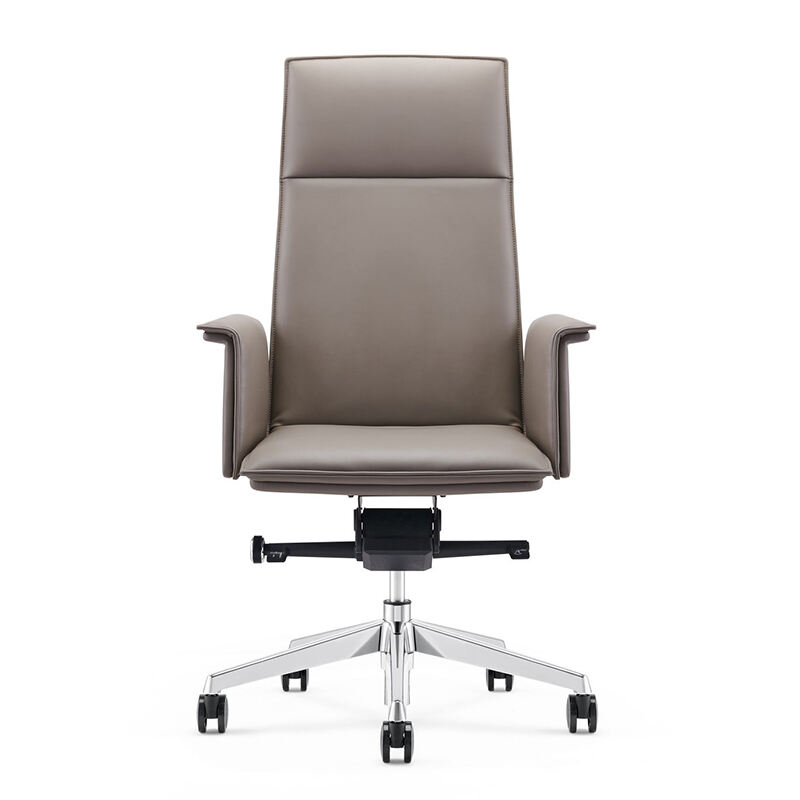In today’s office environments, where employees spend an average of 8+ hours seated daily, the choice of seating directly impacts productivity, health, and overall work performance. Ergonomic chairs—designed to support the body’s natural posture and reduce strain—have emerged as a critical tool in fostering efficient, comfortable workspaces. Unlike generic office chairs, which often force the body into awkward positions, ergonomic chairs adapt to the user’s movements, minimizing discomfort and maximizing focus. Let’s explore how these specialized chairs enhance work performance through targeted support, reduced fatigue, and improved well-being.
Reducing Physical Discomfort and Fatigue
One of the most immediate benefits of ergonomic chairs is their ability to reduce physical discomfort, a major distraction in the workplace. Traditional chairs often lack lumbar support, leading to lower back pain—a common complaint that affects 80% of office workers at some point. Ergonomic chairs address this with adjustable lumbar supports that contour to the natural curve of the spine, preventing slouching and relieving pressure on the lower back. This targeted support ensures the spine remains in a neutral position, reducing muscle strain even during long work sessions.
Ergonomic chairs also feature adjustable seat heights and depths, allowing users to align their hips and knees at a 90-degree angle—critical for proper blood circulation. When feet rest flat on the floor and thighs are parallel to the ground, pressure on the legs and hips decreases, preventing numbness or "falling asleep" sensations that force frequent breaks. Armrests, another key feature of ergonomic chairs, are often height- and width-adjustable, supporting the forearms and reducing shoulder tension when typing or using a mouse.
By minimizing physical discomfort, ergonomic chairs allow employees to stay focused on tasks for longer periods. Studies show that workers using ergonomic chairs report 30% fewer interruptions due to pain or discomfort, translating to more continuous, productive work time. This reduction in fatigue is especially valuable during afternoon slumps, when physical strain tends to peak.
Enhancing Posture and Long-Term Spinal Health
Poor posture in the workplace isn’t just uncomfortable—it can lead to chronic musculoskeletal disorders (MSDs) like herniated discs or tendonitis, which cause long-term absences and reduced productivity. Ergonomic chairs are engineered to promote and maintain healthy posture, acting as a "reminder" for the body to stay aligned.
Features like tilt mechanisms in ergonomic chairs allow users to recline slightly without sacrificing posture, distributing weight evenly across the seat and backrest. This reduces pressure on the spine and encourages natural movement, preventing the stiffness that comes from sitting in one position for too long. Some ergonomic chairs also include pelvic supports or contoured seat pans that cradle the hips, discouraging slouching by making poor posture feel unnatural.
Over time, consistent use of ergonomic chairs trains the body to maintain proper posture even when away from the desk, reducing the risk of long-term injuries. For employers, this means fewer workers’ compensation claims and lower absenteeism—both of which directly impact overall productivity. A 2022 study found that companies investing in ergonomic chairs saw a 25% reduction in MSD-related absences, highlighting the long-term performance benefits of these chairs.
Boosting Focus and Mental Clarity
Physical discomfort doesn’t just affect the body—it also impairs cognitive function. When employees are distracted by back pain, stiff necks, or leg numbness, their ability to concentrate, problem-solve, and make decisions declines. Ergonomic chairs eliminate this distraction by creating a comfortable workspace, allowing the brain to direct its energy toward work tasks.
The link between physical comfort and mental focus is well-documented: research shows that discomfort triggers the body’s stress response, releasing cortisol, which impairs memory and attention to detail. Ergonomic chairs, by reducing physical stress, help maintain lower cortisol levels, supporting sustained focus throughout the workday. This is particularly valuable for tasks requiring high concentration, such as data analysis, writing, or complex problem-solving.
Ergonomic chairs also support micro-movements—small shifts in posture that keep the body engaged without disrupting work. Unlike rigid chairs that lock users into one position, ergonomic chairs with swivel bases and smooth-rolling casters allow easy reach to files, printers, or colleagues, reducing the need for awkward stretching or standing. These seamless movements keep the mind in "work mode" instead of shifting to "discomfort mode," maintaining a steady workflow.

Supporting Diversity and Inclusivity
Workplaces are diverse, with employees of varying heights, weights, and physical needs. One-size-fits-all chairs fail to accommodate these differences, leaving many workers unsupported and uncomfortable. Ergonomic chairs, with their adjustable features, promote inclusivity by adapting to a wide range of body types.
For example, a tall employee can raise the seat height and extend the backrest of an ergonomic chair to support their longer torso, while a shorter user can lower the seat and adjust the armrests to fit their frame. Users with broader hips benefit from wider seat pans in ergonomic chairs, while those with mobility issues appreciate lever controls that are easy to reach and operate. This customization ensures every employee—regardless of size or ability—has access to comfortable seating, reducing disparities in performance and well-being.
Inclusive workplaces also see higher employee engagement, as workers feel valued and supported. When ergonomic chairs are provided to all, it sends a message that the company prioritizes equity, fostering a culture where everyone can perform at their best.
Reducing Absenteeism and Healthcare Costs
Chronic pain and MSDs are leading causes of workplace absenteeism, costing companies billions annually in lost productivity and healthcare expenses. Ergonomic chairs act as a preventive measure, reducing the risk of these issues and their associated costs.
A study by the Occupational Safety and Health Administration (OSHA) found that employers who invested in ergonomic furniture, including ergonomic chairs, saw a 40% reduction in MSD-related absences. This translates to fewer missed workdays and lower reliance on temporary staff, keeping projects on track and teams functioning smoothly. Additionally, employees using ergonomic chairs report fewer visits to healthcare providers for back or neck pain, reducing insurance claims and associated costs.
For remote workers, ergonomic chairs are equally impactful. With more employees working from home, inadequate seating has become a common issue, leading to increased discomfort and lost productivity. Providing ergonomic chairs to remote teams ensures consistent support across all work environments, maintaining performance standards regardless of location.
FAQ: Ergonomic Chairs and Work Performance
How long does it take to notice improved performance with ergonomic chairs?
Many users report reduced discomfort within the first week, with noticeable improvements in focus and productivity within 2–4 weeks. Long-term benefits, such as reduced MSD risk, become evident over months of consistent use.
Are expensive ergonomic chairs worth the investment?
Mid-range to high-quality ergonomic chairs (typically 800) are worth the investment, as they offer durable materials and advanced adjustability. Cheaper "ergonomic-style" chairs often lack critical features (e.g., adjustable lumbar support) and may not provide lasting benefits. The ROI comes from reduced absenteeism and improved productivity.
Can ergonomic chairs help with existing back pain?
Yes, when used properly. Ergonomic chairs with targeted lumbar support can alleviate mild to moderate back pain by reducing pressure on the spine. However, severe pain should be evaluated by a healthcare provider, who may recommend specific chair features or additional treatments.
Do ergonomic chairs work for all types of work (e.g., standing desks, collaborative spaces)?
Ergonomic chairs are most effective for seated work, but many pair well with standing desks—users can alternate between sitting and standing, using the chair during seated intervals. For collaborative spaces, ergonomic task chairs with mobility (e.g., swivel bases) allow easy movement between workstations without sacrificing support.
How do I choose the right ergonomic chair for my team?
Prioritize adjustable features: lumbar support, seat height/depth, armrests, and tilt. Test chairs with a diverse group of employees to ensure they accommodate different body types. Look for certifications like BIFMA (which ensures durability) and positive user reviews focusing on comfort during long sessions.
Table of Contents
- In today’s office environments, where employees spend an average of 8+ hours seated daily, the choice of seating directly impacts productivity, health, and overall work performance. Ergonomic chairs—designed to support the body’s natural posture and reduce strain—have emerged as a critical tool in fostering efficient, comfortable workspaces. Unlike generic office chairs, which often force the body into awkward positions, ergonomic chairs adapt to the user’s movements, minimizing discomfort and maximizing focus. Let’s explore how these specialized chairs enhance work performance through targeted support, reduced fatigue, and improved well-being.
-
FAQ: Ergonomic Chairs and Work Performance
- How long does it take to notice improved performance with ergonomic chairs?
- Are expensive ergonomic chairs worth the investment?
- Can ergonomic chairs help with existing back pain?
- Do ergonomic chairs work for all types of work (e.g., standing desks, collaborative spaces)?
- How do I choose the right ergonomic chair for my team?





